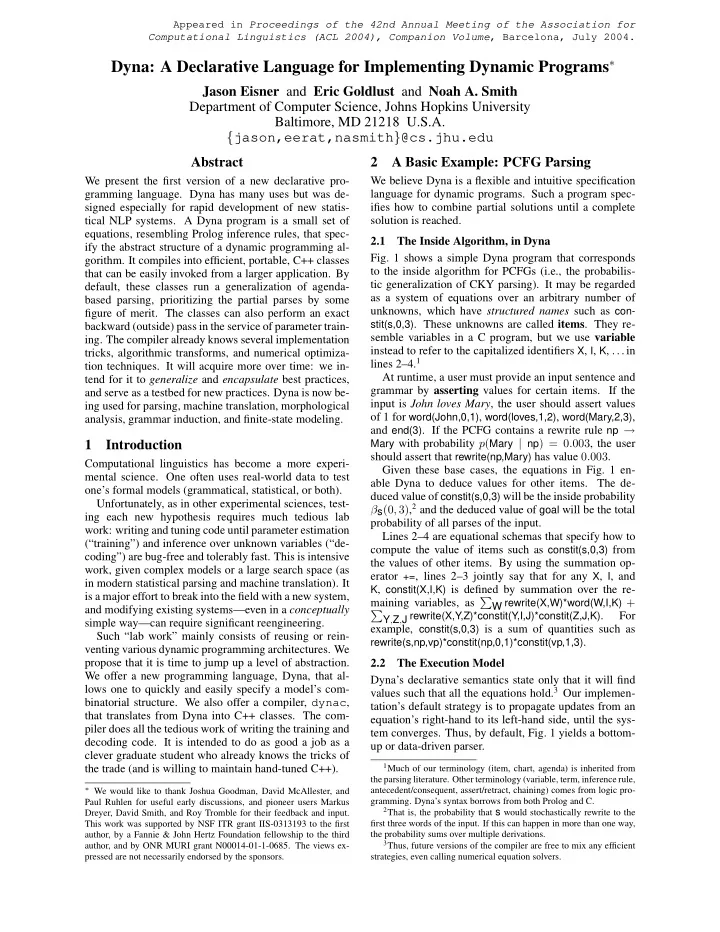

Appeared in Proceedings of the 42nd Annual Meeting of the Association for Computational Linguistics (ACL 2004), Companion Volume , Barcelona, July 2004. Dyna: A Declarative Language for Implementing Dynamic Programs ∗ Jason Eisner and Eric Goldlust and Noah A. Smith Department of Computer Science, Johns Hopkins University Baltimore, MD 21218 U.S.A. { jason,eerat,nasmith } @cs.jhu.edu Abstract 2 A Basic Example: PCFG Parsing We present the first version of a new declarative pro- We believe Dyna is a flexible and intuitive specification language for dynamic programs. Such a program spec- gramming language. Dyna has many uses but was de- signed especially for rapid development of new statis- ifies how to combine partial solutions until a complete tical NLP systems. A Dyna program is a small set of solution is reached. equations, resembling Prolog inference rules, that spec- 2.1 The Inside Algorithm, in Dyna ify the abstract structure of a dynamic programming al- Fig. 1 shows a simple Dyna program that corresponds gorithm. It compiles into efficient, portable, C++ classes to the inside algorithm for PCFGs (i.e., the probabilis- that can be easily invoked from a larger application. By tic generalization of CKY parsing). It may be regarded default, these classes run a generalization of agenda- as a system of equations over an arbitrary number of based parsing, prioritizing the partial parses by some unknowns, which have structured names such as con- figure of merit. The classes can also perform an exact stit(s,0,3) . These unknowns are called items . They re- backward (outside) pass in the service of parameter train- semble variables in a C program, but we use variable ing. The compiler already knows several implementation instead to refer to the capitalized identifiers X , I , K , ...in tricks, algorithmic transforms, and numerical optimiza- lines 2–4. 1 tion techniques. It will acquire more over time: we in- At runtime, a user must provide an input sentence and tend for it to generalize and encapsulate best practices, grammar by asserting values for certain items. If the and serve as a testbed for new practices. Dyna is now be- input is John loves Mary , the user should assert values ing used for parsing, machine translation, morphological of 1 for word(John,0,1) , word(loves,1,2) , word(Mary,2,3) , analysis, grammar induction, and finite-state modeling. and end(3) . If the PCFG contains a rewrite rule np → Mary with probability p ( Mary | np ) = 0 . 003 , the user 1 Introduction should assert that rewrite(np,Mary) has value 0 . 003 . Computational linguistics has become a more experi- Given these base cases, the equations in Fig. 1 en- mental science. One often uses real-world data to test able Dyna to deduce values for other items. The de- one’s formal models (grammatical, statistical, or both). duced value of constit(s,0,3) will be the inside probability Unfortunately, as in other experimental sciences, test- β s (0 , 3) , 2 and the deduced value of goal will be the total ing each new hypothesis requires much tedious lab probability of all parses of the input. work: writing and tuning code until parameter estimation Lines 2–4 are equational schemas that specify how to (“training”) and inference over unknown variables (“de- compute the value of items such as constit(s,0,3) from coding”) are bug-free and tolerably fast. This is intensive the values of other items. By using the summation op- work, given complex models or a large search space (as erator += , lines 2–3 jointly say that for any X , I , and in modern statistical parsing and machine translation). It K , constit(X,I,K) is defined by summation over the re- is a major effort to break into the field with a new system, maining variables, as � W rewrite(X,W)*word(W,I,K) + and modifying existing systems—even in a conceptually � Y , Z , J rewrite(X,Y,Z)*constit(Y,I,J)*constit(Z,J,K) . For simple way—can require significant reengineering. example, constit(s,0,3) is a sum of quantities such as Such “lab work” mainly consists of reusing or rein- rewrite(s,np,vp)*constit(np,0,1)*constit(vp,1,3) . venting various dynamic programming architectures. We propose that it is time to jump up a level of abstraction. 2.2 The Execution Model We offer a new programming language, Dyna, that al- Dyna’s declarative semantics state only that it will find values such that all the equations hold. 3 Our implemen- lows one to quickly and easily specify a model’s com- binatorial structure. We also offer a compiler, dynac , tation’s default strategy is to propagate updates from an that translates from Dyna into C++ classes. The com- equation’s right-hand to its left-hand side, until the sys- piler does all the tedious work of writing the training and tem converges. Thus, by default, Fig. 1 yields a bottom- decoding code. It is intended to do as good a job as a up or data-driven parser. clever graduate student who already knows the tricks of 1 Much of our terminology (item, chart, agenda) is inherited from the trade (and is willing to maintain hand-tuned C++). the parsing literature. Other terminology (variable, term, inference rule, ∗ We would like to thank Joshua Goodman, David McAllester, and antecedent/consequent, assert/retract, chaining) comes from logic pro- gramming. Dyna’s syntax borrows from both Prolog and C. Paul Ruhlen for useful early discussions, and pioneer users Markus 2 That is, the probability that s would stochastically rewrite to the Dreyer, David Smith, and Roy Tromble for their feedback and input. first three words of the input. If this can happen in more than one way, This work was supported by NSF ITR grant IIS-0313193 to the first author, by a Fannie & John Hertz Foundation fellowship to the third the probability sums over multiple derivations. 3 Thus, future versions of the compiler are free to mix any efficient author, and by ONR MURI grant N00014-01-1-0685. The views ex- pressed are not necessarily endorsed by the sponsors. strategies, even calling numerical equation solvers.
Recommend
More recommend